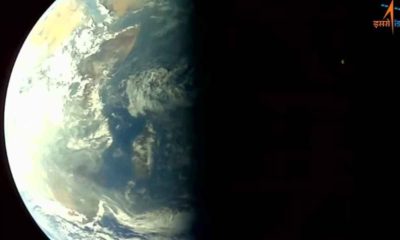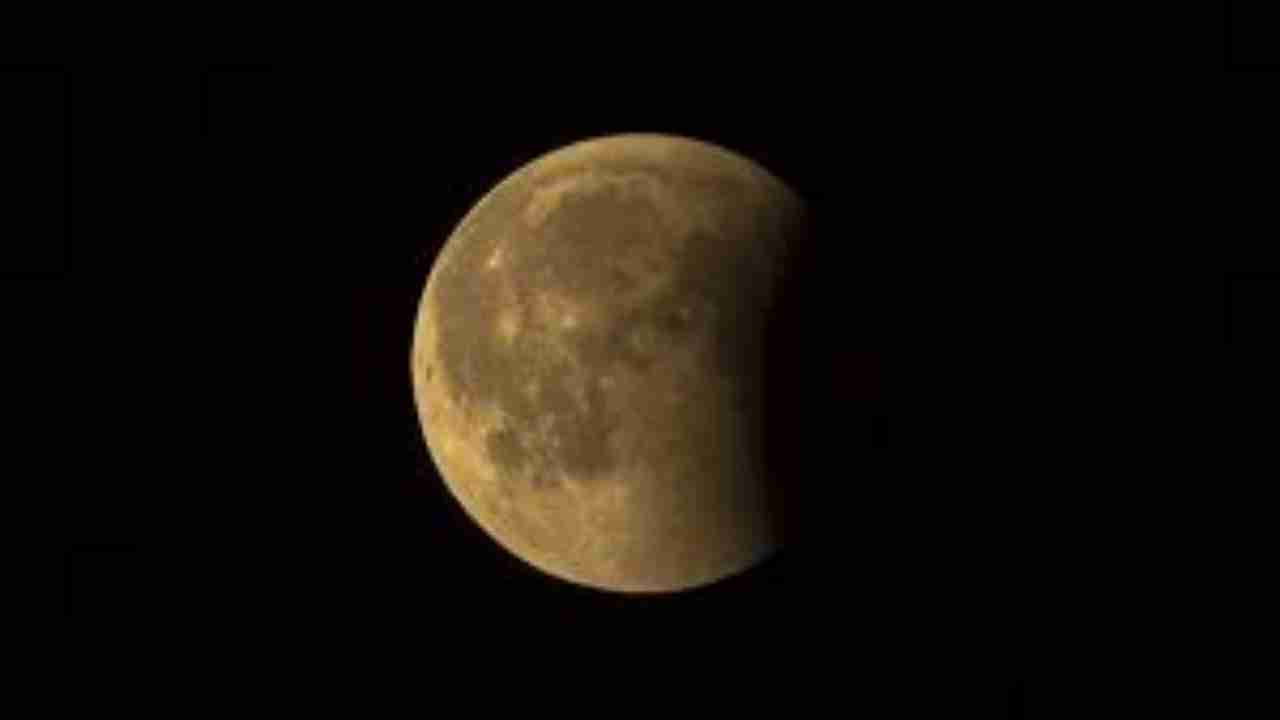Gadgets
The Lunar Eclipse of 31 January : Let us not be frightened of our own shadow!

~By Dr. Niruj Ramanujam
In the evening of 31 January, as we look towards the eastern sky, we will be witness to the dance of shadows that our Solar System regularly conjures up, as our Earth and the Moon move inexorably in their cosmic orbits around the Sun. As the Full Moon passes through the Earth’s shadow, it will be eclipsed for a few hours. What is more, this will be a total lunar eclipse, most of which can be seen from all of India. What is important is that we all go outside and see this majestic spectacle that nature will orchestrate for a few hours, and that we get our friends, family, and our communities to share in it too.
Eclipses have fascinated, awed and frightened humanity for millennia. More than 2000 years ago, when we did not understand what eclipses were, the sight of the Sun or the Moon in the unchanging sky being covered by something unknown must have been scary. In every culture, there are stories of some strange beast swallowing the Sun or the Moon – a dragon in China, a frog in Vietnam, a bird in Hungary, a bear in Siberia, a snake for Mayans, and of course, Rahu and Ketu in India. However, in each of these cultures, as local scientists came to an understanding of eclipses, fear and awe slowly gave way to understanding and appreciation.
In India, the earliest stories involved the demon Svarbhanu, who was later identified with Rahu and the story of the churning of nectar. Ketu, which used to be the name for comets and meteors, also became identified with the eclipse. With the introduction of astrology from the Greeks, this identification was further solidified. It was left to the genius of Aryabhata (476-550 C.E.), born in present day Patna, to correctly explain the cause of eclipses and also give a method for calculating them accurately. His method was refined by other astronomers in India over the next few centuries, and is still used in many parts of the country.
We all learn in school now that a solar eclipse is caused when the Moon’s shadow falls on the Earth, and a lunar eclipse occurs when the Earth’s shadow falls on the Moon. Why then, we often ask, do we not get eclipses every full and new moon? The orbit of the moon around the earth and the orbit of the earth around the sun are not in the same plane, but are tilted at about 5 degrees with respect to each other. Hence, during a typical new moon or full moon, the sun, earth and the moon do not fall exactly in a straight line. For example, during most new moons, the moon passes close to the sun in the sky, but does not come close enough to cover it, and likewise for the full moon.
On 31 January, the Sun, Earth and the Moon will once again fall in a straight line, and we will get to see a Total Lunar Eclipse. The shadow of the Earth and the Moon have an umbra, which is the really dark part, and the penumbra, where it is not fully dark. You can understand this by holding an object some distance from a piece of paper and looking at the shadow. In this lunar eclipse, the Full Moon will first enter the penumbral shadow and will appear a bit dimmer. This stage is easy to miss. Then the moon will enter the umbral shadow, the partial eclipse, when we can clearly see the shape of the Earth’s shadow slowly covering the Moon. When the Moon is covered to a larger extent, we will notice that the colour of the Moon turns red. When the Moon is completely eclipsed, it will be quire red in colour, and hence the name blood moon. Then the whole process happens reverse till the Moon completely leaves the Earth’s shadow. On 31 Jan, the partial eclipse starts at 5.18 pm, total eclipse lasts from 6.22 to 7.38 pm, and the partial eclipse ends at 8.41 pm. The penumbral eclipse then ends at 9.39 pm.
Unfortunately, we cannot see the entire eclipse from India – the Moon will rise only when the eclipse has already begun. However, since the Moon rises later as we move westwards, the more east you are, more of the eclipse can be seen from your location. The Moon will rise at 4.47 pm in Itanagar, 5.16 pm in Kolkata, 5.25 pm in Patna, 5.53 pm in Delhi, 6.04 in Chennai and 6.27 in Mumbai. We can then figure out which stages of the eclipse we will be able to see from our location.
This eclipse is being called the ‘Super Blue Blood Moon’. Let us unpack this strange epithet. The Moon goes around the Earth in an elliptical orbit. This means that its distance from us varies periodically as it goes around us, but not by much. During perigee, when it is closest to us, it is only 14% bigger than during apogee, when it is farthest from us.
Perigee of the Moon happens once every 27.3 days. When a perigee coincides with a Full Moon, we call it a Super Moon. This time, the perigee happens on 30 Jan, and hence this eclipse is a ‘Super Moon Eclipse’. However, any increase in size or brightness compared to usual, will not be easily obvious. A Blue Moon is not really blue. When we get two Full Moons in a single month, we call it a blue moon, and we have two such this month. Lastly, since the eclipsed moon is red in colour, we call it the Blood Moon. Nothing strange, as you can see!
It is best to go outside the previous day and locate a spot from where you have an unobstructed view of the eastern sky, where there are no very bright lights. It is also useful to note from which position in the horizon the Moon rises on the previous day. Then, on 31 Jan, take your friends and family, go out, and look for the rising eclipses Moon. Sit down, relax, and watch the glorious spectacle unfold in front of you as the Moon climbs higher in the sky. And don’t forget to eat while doing so – it is perfectly safe to do so too!
There are many myths and beliefs about eclipses in every culture, including in India, which scare people into not seeing eclipses. An eclipse is just a shadow phenomenon. There is no extra radiation during an eclipse. If at all, there is less radiation than usual. There is also no effect due to gravity during an eclipse. The change in gravity due to the lining up of the Sun, Earth and Moon in a line is no larger than standing next to a large hill or next to a multi-storey building. None of the beliefs about the harmful nature of eclipses have any basis in science or on fact. These beliefs can actually be quite harmful, for example, when pregnant women close to delivery refusing treatment during an eclipse, or people with health issues not eating or drinking in this period. Instead, go out with your family and friends, and enjoy the eclipse without fear!
The Public Outreach and Education Committee of the Astronomical Society of India has set up a web-page for the eclipse, where there is information on eclipse timings, maps and animations, articles and videos in English and many Indian languages, as well as a crowd-sourced map of public eclipse parties across India. You can look at this map to locate the nearest eclipse watching event. So far we have more than 100 such events! The website is at http://bit.ly/eclipse31jan
Carl Sagan said, in his book Cosmos, “The reappearance of the crescent moon after the new moon; the return of the Sun after a total eclipse, the rising of the Sun in the morning after its troublesome absence at night were noted by people around the world; these phenomena spoke to our ancestors of the possibility of surviving death. Up there in the skies was also a metaphor of immortality”.
We usually go about our lives, unmindful of our world, let alone our universe. Now and then, the universe steps into our life with an eclipse and makes us aware not just of the sheer vastness of space, but also of how the seemingly unchanging sky is actually a place of constant motion. Such occasions, to be a part of something larger than ourselves, even as large as the entire solar system, come but rarely. Let us not waste it by cowering in our houses, scared of, literally, our own shadow! (India Science Wire)
(Dr Niruj Ramanujam is associated with National Centre for Radio Astrophysics (NCRA-TIFR) and Public Outreach and Education Committee of the Astronomical Society of India)
Gadgets
WhatsApp to introduce Native File Sharing feature similar to Apple’s AirDrop
Users can choose to be visible to others without disclosing their phone numbers to people who are not their contacts.

A Meta-owned messaging platform, WhatsApp is all set to introduce a new feature that allows Android users to share files with another user nearby. According to reports, the feature will be developed similar to Apple’s AirDrop.
The file sharing feature nearby is not currently available for beta testers. However, according to a report from WhatsApp feature tracker WABetaInfo, it seems that the feature will soon be introduced. The report reveals a screenshot that shows an option within the app stating, to share files with people nearby, along with a list of nearby users.
It is interesting to note that users can choose to be visible to others without disclosing their phone numbers to people who are not their contacts. In order to share files with other users, one needs to wait for nearby users to accept their request. The process involves a unique interaction, where nearby users can shake their device to receive incoming share requests. It is important to note that this feature is designed with end-to-end encryption to ensure user privacy.
In the upcoming update, WhatsApp is expected to introduce a nearby file-sharing feature. However, the current beta version for Android, which is 2.24.2.20, has addressed a camera issue. Some Android beta testers have reported difficulties in launching the camera within the app after the 2.24.2.13 update. Upon launching, users were presented with an error message that said, can’t start camera, please restart your device. This issue persisted even after restarting the device or relaunching the app.
The latest beta update of WhatsApp, located at 2.24.2.20, has fixed the camera bug. This allows users to launch the camera within the app and share photos and videos with their contacts without any interruptions. As WhatsApp continues its efforts to improve its features and address bugs, users can expect a better messaging experience on the platform.
Gadgets
Meesho mega blockbuster sale: E-commerce platform to offer 80 percent discount on electronics
The e-commerce platform’s first mega blockbuster sale will sell more than 400 brands directly with the help of authorised partners on its digital store called Meesho Mall.

Ahead of the festive season, e-commerce platform Meesho’s mega blockbuster sale is starting on Friday, October 6, 2023. The platform will provide a massive discount of up to 80 percent on different categories such as essentials, accessories, electronics, footwear, etc.
The blockbuster sale is scheduled to conclude on October 13, 2023. Notably, the Softbank backed e-commerce platform is starting its festive sale a day before Flipkart or Amazon’s festive sale goes live. The e-commerce platform’s first mega blockbuster sale will sell more than 400 brands directly with the help of authorised partners on its digital store called Meesho Mall.
Reportedly, the platform also added over 50 lakh new customers during these sales. More than 75 percent of the demand was received from Tier-II cities, including Amravati, Aurangabad, Dehradun, Nellore, Solapur, and Warangal. The platform further claimed that they have added more than 2 lakh sellers in the past two years.
Recently, Meesho affirmed that they have received over 10 million (approx) from its pre-festive sales during Onam, Raksha Bandhan, and Ganesh Chaturthi. The platform has more than 14 lakh sellers, selling approx 12 crore products in 30 different categories.
In an effort to increase the seller base, the company announced the onboarding of non-GST sellers on the platform earlier this week. The GST council announced to permit the e-commerce platform to onboard sellers with turnover of up to Rs 40 lakh.
Prior to Meesho’s Mega Blockbuster Sale, the company introduced a loyalty programme during which eligible users will earn Smart Coins, which the user can redeem every time they make the purchase of any products on the platform.
As per Redseer, over 140 million shoppers are likely to make purchases during the festive season. This will enhance the Gross Merchandise Value (GMV) of the Indian e-commerce sector by 18 to 20 per cent and may touch Rs 90,000 crore as compared to Rs 76,000 crore last year.
Phones & gadgets
Apple launches iPhone 15 series, India price, features, availability
The iPhone 15 series will be available in India from September 22 but iPhone lovers can also pre-order, starting from September 15 onwards.

Apple launched its most anticipated iPhone 15 series, including the iPhone 15, iPhone 15 Plus, iPhone 15 Pro and iPhone 15 Pro Max during the Wonderlust event globally on September 12 night.
The iPhone 15 series will be available in India from September 22 but iPhone lovers can also pre-order, starting from September 15 onwards.
People can buy a new iPhone 15 or upgrade it to the old one. There are five colours available for the people.
According to reports, Apple has been manufacturing the iPhone 15 series in India and China. Apple has moved 7% of its iPhone production to India. Previously, India was not making the newest models. The Centre’s production-linked incentive (PLI) scheme for smartphones played a part in Apple moving its production to India.
The new iPhone 15 has been launched with the same starting price as its prototype, the iPhone 14. The 128GB variant is priced at Rs 79,900, while the 256GB variant costs Rs 89,900. For people who need more storage, the 512GB variant is available for Rs 1,09,900.
This latest iPhone series puffs a 6.1-inch display and comes in five different colours which are pink, yellow, green, blue, and black. While the design remains the same as the previous models, the iPhone 15 features a dynamic island notch instead of the usual notch, which was highly popular among the iPhone 14 Pro phones.
The camera part of the iPhone series has undergone significant upgrades, the new iPhone 15, with an enhanced 48-megapixel primary sensor replaces the 12-megapixel dual camera system which was available in the previous iPhone 14. This significant improvement promises better low-light photography and portrait shots.
The tech giant announced that the iPhone 15 has an all-day battery life, making it more convenient for users to go about their daily activities without worrying about their phone’s battery.
The iPhone 15 Pro models feature a lighter body and thinner bezels. The new AirPods Pro with USB-C charging case will support Lossless Audio with Apple Vision Pro.
Additionally, the iPhone 15 is powered by Apple’s A16 bionic processor, an upgrade from the A15 bionic chipset used in the previous iPhone 14 and iPhone 14 Plus models. The Pro models had the faster and better A16 chip, but now this feature is available in all iPhone 15 models.
The USB-C port on the standard iPhone 15 and iPhone 15 Plus remain limited to lightning speeds up to 480 Mbps. The iPhone 15 Pro and iPhone 15 Pro Max support USB 3 speeds up to 10 Gbps. People will need to buy a separate 1-meter Thunderbolt 4 Pro cable for Rs 5,724 or Rs 10,701 for the 1.8-meter cable to support faster speeds.
The dynamic island notch feature, which can adjust its size according to notifications, was widely discussed before the launch of the iPhone 15. This unique feature can now be available in all models of the phone.
Another important feature of the iPhone 15 is the shift to the USB Type C charging port. Apple has abandoned the lightning port in favour of the more commonly used USB Type C charging port. This means, there is no longer a need for a special iPhone charging cable to be carried around everywhere you go.
-

 2024 Lok Sabha Elections16 hours ago
2024 Lok Sabha Elections16 hours agoLok Sabha election 2024: Nearly 50% voter turnout recorded in second phase till 3 pm
-

 2024 Lok Sabha Elections21 hours ago
2024 Lok Sabha Elections21 hours agoPM Modi calls for high voter turnout in second phase of Lok Sabha elections 2024, says your vote is your voice
-

 India News20 hours ago
India News20 hours agoSalman Khan house firing case: NIA interrogates arrested shooters Sagar Pal, Vicky Gupta for three hours
-

 2024 Lok Sabha Elections19 hours ago
2024 Lok Sabha Elections19 hours agoLok Sabha elections 2024: 102-year-old man walks to polling booth to cast his vote in Jammu
-

 2024 Lok Sabha Elections14 hours ago
2024 Lok Sabha Elections14 hours agoElection Commission books BJP MP Tejasvi Surya for seeking votes in the name of religion












